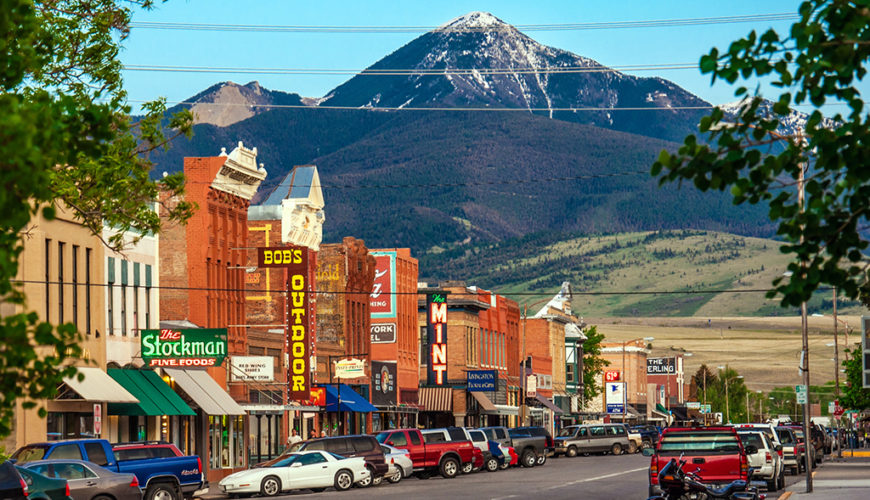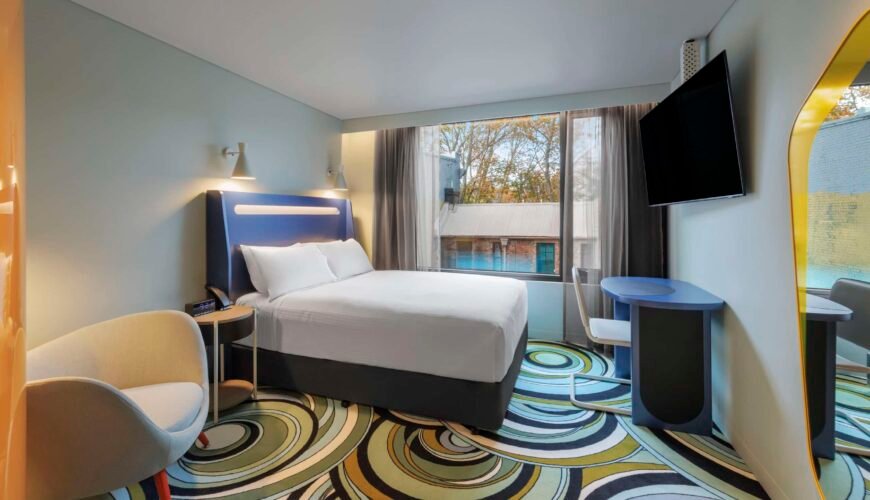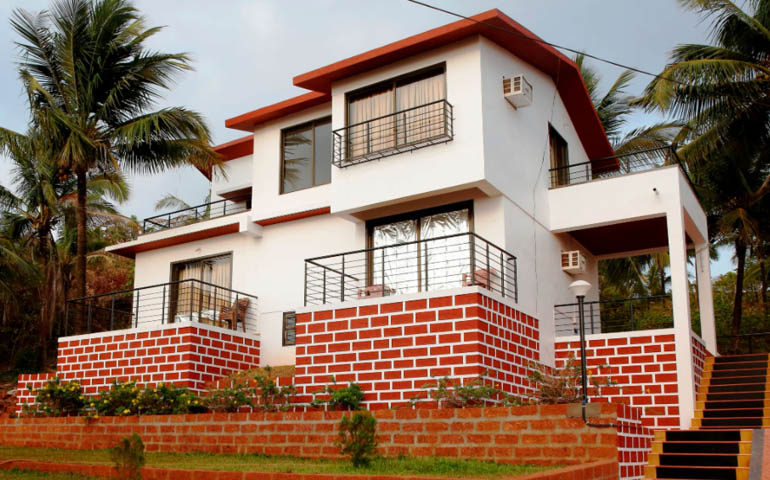Located in the north western part of the United States,Montana has earned its name as the treasure state thanks to its striking combination of stunning natural areas, plethora of outdoor activities to enjoy, a varied wildlife that includes grizzly bears, a rich historic past, lively cities and a breathtaking landscape. Sprawled across jagged peaks and expansive prairies, Montana has an important American West heritage that is well taken care of, especially at historic centers such as Billings and Helena, the state capital city.
Visit Helena, Montana’s Capital City
Starting your trip through Montana in Helena is a great idea! It’s the perfect starting point to explore much of what’s fascinating about this state. It offers an interesting balance of modern and historic buildings as the city has preserved many of the old buildings and attractions that made it popular during the post-gold rush era. Make sure you don’t miss the Cathedral of St Helena, take a walk down the historic district and spend some time at the Holter Museum just for a start!
And if you love nature, visit Helena National Forest, hike the Continental Divide National Scenic Trail and stop by the Elkhorn Wildlife Management Unit to see some wonderful big game!

Helena is also home to the historic mining district known as Reeder’s Alley and the XIX century Old Fire Tower. Nicknamed the Queen City of the Rockies, it used to be a gold camp during the gold rush and it was one of the wealthiest cities in the late XIX century. It’s a lovely city to visit, with its laid back and friendly atmosphere.
Helena is home to the State Capitol and it’s definitely a must-see. Built in Greek Renaissance style, granite and sandstone constitute much of its facade. It’s topped with a copper dome and it houses several eye-catching murals featuring themes of Montana’s past. Entry to the Capitol is free and once there visitors can see libraries, different legislative halls, the rotunda dome and many beautiful staircases.
Another highlight in Helena is the Montana Historical Society Museum. It educates visitors on the history of the state. Its exhibits contain old artifacts, art and archaeological items. There’s also an extensive collection of art, photos, oral archives and manuscripts.
Visit Billings

Billings is the largest city in Montana and a great base for travellers exploring the south of Montana. Offering a plethora of activities for visitors of all ages, it’s also famous for its great food scene.
Just as much of the state, Billings offers plenty of opportunities to be in contact with nature. There are multiple hiking trails and parks to enjoy such as Pictograph Caves State Park or Four Dances Recreation Area, which are great for children. For indoor fun, head to Yellowstone County Museum, Wise Wonders Children’s Museum or Yellowstone Art Museum.
Experience Nature at Glacier National Park
Located at the border of the United States and Canada, Glacier National Park is one of the most important attractions in Montana and a must-see, must-go, must-experience for nature and adventure lovers spending some time in Montana. The park itself is huge and it seduces visitors with a plethora of varied outdoor activities and opportunities to admire nature at its best.
From a physical point of view, Glacier National Park is huge. There are lots of crystal-clear lakes, mountains and glaciers that are said to be the major sources of water of the Pacific Ocean. Mount Grinnell, at the heart of the park, is stunning and only increases the beauty of the park. The coniferous and deciduous forest is home to many wild species of plants and animals!
Glacier National Park is an outstanding scenic area that comprises mountain ranges, alpine meadows, thick forests, tall waterfalls, countless lakes and numerous glaciers. It’s an outdoor lover’s paradise offering plenty of opportunities for hiking, sailing, bird watching, biking, rafting and much more!
The area has become a tourist destination since it got connected to the Great Northern Railway in the late XIX century and it’s now still possible to experience the beauty of the area aboard a train. Yes! Amtrak’s Empire Builder runs through the park all year round and has stops in East and West Glacier. The Amtrak Glacier experience includes dining and champagne. The train is equipped with a panoramic observation car with floor to ceiling windows. Can you think of a more wonderful experience?
July and August are the best time to visit this national park as during these months the weather conditions are at its most ideal.
What to See and Do at Glacier National Park
Lake McDonald and Iceberg Lake

Lake McDonald is the largest and most popular lake at the park. Located in the west of Glacier National Park, it is surrounded by mountains and offers spectacular views all year round. The eastern shore of the lake borders the Continental Divide. Lake McDonald valley’s flora is dominated by western red cedar, fir, spruce and hemlock while animal lovers can spot mule deer, elk, mountain goats and grizzly bears. The lake lies on an elevation of 961 ms and it was once occupied by a glacier.
Apart from its stunning natural beauty, it’s one of the best things to do in Montana and it’s possible to explore its many hiking trails. The Trail of the Cedars is among the most accessible ones in Glacier National Park: a one-mile loop trail that starts and ends on the Going To The Sun Road. Equally easy is the 2-mi Avalanche Lake Trail with an elevation of 152m; it features a waterfall and a lake and it starts at Avalanche Picnic Area.
Iceberg Lake, located on the NE part of this National Park, can be found between Mount Wilbur in the south and Iceberg Peak and the Continental Divide in the west. It’s an alpine lake that lies at 6094 feet and, as it is shaded from the sun by the mountains, it’s known to have snow most of the summer months. It’s a popular hiking destination; the Iceberg Lake trail is located near tourist cabins. The area is known for the abundance of grizzly bears so be ready to encounter some wildlife.
Logan Pass
At 2025 meters, Logan Pass is the highest point on Going To The Sun Road and part of the Continental Divide and it’s the highest point in Glacier National Park that can be reached by car. From here you can enjoy sweeping views across Glacier National Park and admire jagged mountains, fields of wildflowers and, if lucky, spot mountain goats, bighorn sheep and other wildlife.
It’s one of the most favorite areas in Glacier National Park amongst visitors for its interesting combination of stunning landscapes and great wildlife! Logan Pass is definitely a must-do, also amongst hikers as there are a couple of interesting hiking trails nearby.
Hiking in Glacier National Park
Glacier National Park reopens for hikers in late May or early June despite some trails and higher elevations remaining under snow until mid July. By early September snow appears on some high elevation trails and, by the end of October, the hiking season is over.
Many people opt to do at least one hike in the park during their stay. In fact, there’s probably no better way to experience the beauty and majesty of Glacier National Park than from a hiking trail. With so many trails to choose from, you’ll definitely find one that is perfectly suitable for your skills and expectations. Some are short and easy while others are longer and more demanding. We’ve compiled a few from easiest to the most difficult ones: Trail of the Cedars Nature Trail, Avalanche Lake, Cracker Lake Hike, Iceberg Lake or the boardwalk at Logan Pass.
One of the most famous hikes in Glacier National Park is Highline Trail. It starts at the trailhead near the Logan Pass Visitor Center parking lot. It’s 11.5km long and it features: Grinnell Glacier Overlook, Granite Park Chalet and Garden Wall. It’s a challenging trail with an elevation gain of 190 m, many descents and ascents and a series of switchbacks when approaching Haystack Pass.
Birdwatching at Glacier
Bird lovers find visiting Glacier to be a really fascinating experience as it is home to 260 bird species including forest, aquatic and terrestrial birds. To increase your chances, make sure you visit the park between May and August.
Grizzly Bears in Glacier National Park

With only 800 grizzly bears left in Montana and most of them living in Glacier National Park, encounters with this species are not rare at all, especially after the winter months when the weather gets warmer and on the east side of Glacier since bears often descend to lowland meadows and forests as they search for food. The biggest chance to spot them is in Grinnell Glacier Trail, Iceberg Lake Trail, Logan Pass and Cracker Lane Trail.
Visitors should remember at all times that bears are dangerous and they shouldn’t be approached closer than 90 meters. Make a lot of noise when hiking so a bear can hear you and run away and always carry a bear spray to deter attacks.
Drive the Going To The Sun Road
Going To The Sun Road is a splendid two-lance mountain highway in Glacier National Park. It’s 80 km long and it’s the only road that crosses the Glacier National Park. At the height of 2026 m, it traverses the Continental Divide via Logan Pass, which is officially the highest point of the road.
Visitors coming from further states, can rent a car and take advantage of the four wheels to explore different areas of the park and, of course, drive along this stunning road. It’s very well maintained and you can always rely on insurance to provide you with the coverage and protection you need in case the unexpected happens.
Several sections of Going To The Sun Road remain open all year round and provide access to many locations and activities but summer is the only time of the year in which all sections are available. It’s the most scenic drive in the park and one of the most beautiful ones in the United States. Full of twists and turns through the mountains, it offers breathtaking views and plenty of opportunities to hop off the car, stretch your legs, take stunning photographs and hike some trails.
For your safety, bear in mind that the road is narrow and winding and that very large vehicles or trailers longer than 6.4m are not allowed.
Visit Yellowstone National Park
Yellowstone National Park is one of the most beloved national parks in the United States. It covers an extensive area of Montana, Wyoming and Idaho and it’s blessed with geothermal spots, jagged mountains, subalpine forests and much more. The upper Geyser Basin attracts lots of tourists every year. The park is also home to an interesting and varied wildlife and visitors can spot coyotes, white tailed deer and pronghorns.
No visit to Yellowstone National Park will be complete without spending some time walking around the boardwalks and admiring some of the many geysers in the Upper Geyser Basin such as Castle, Grotto, Riverside and Daisy. Make sure you don’t miss the Morning Glory Pool, one of the most colorful thermal features in all Yellowstone. The Old Faithful is the star of Yellowstone National Park and you can’t leave the park without experiencing at least one of its eruptions. Although it’s not the largest or most regular geyser in the park, it erupts more frequently than other big geysers. Its average interval between eruptions is about 90 minutes, eruptions last 5 minutes on average and expel 14000-32000 liters of water.
For another breathtaking view see the Grand Canyon of the Yellowstone. It may not be as big or as impressive as the one in Arizona but it’s stunning nonetheless and it’s one of the most photographed features in all of Yellowstone. There are numerous vantage points on the North and South sides of the canyon and you’re advised to take the time to view it from both sides. Also, take the ⅜ mile hike down to the edge of the Lower Falls for an exciting experience!
Learn about Butte’s Mining Past at the World Museum of Mining
The town of Butte was a hotbed of copper mining activity for a century and, today, that rich history comes to life at the World Museum of Mining. The museum, opened in the early 1960s, it’s located within the Orphan GIrl mine yard where visitors can experience what life was like at a mining camp or take an underground tour.
There are more than 36 historic buildings and structures on display. One of the highlights is the huge headframe along with the underground tours of the mines. There are more than 60 exhibits at the museum where artifacts from the mining days are on display.
Say Hello to Dinosaurs at the Museum of the Rockies

Located in Montana’s town of Bozeman, the Museum of the Rockies is one of the most interesting attractions in Montana. Along with its planetarium, the museum is famous for its excellent displays of dinosaurs and dinosaur eggs. The stunning collection includes both skeletons and realistic models of the numerous species found in the state. You can’t miss the world’s biggest Tyrannosaurus skull, a T-Rex thigh bone with soft tissue remains and Big Mike, the T-Rex skeleton at the entrance.
However, there is much more to see than just dinosaurs! The Museum of the Rockies also features a dynamic display welcoming people to Yellowstone country, native peoples of the region, Western art exhibits and the Tinsley House _ an original pioneer log home from the late 1800s.
It’s definitely the place to go for dinosaur loves and for anybody interested in exploring Montana’s past! Take your time to admire artifacts of the Plains American Indians and many pioneer exhibits.




